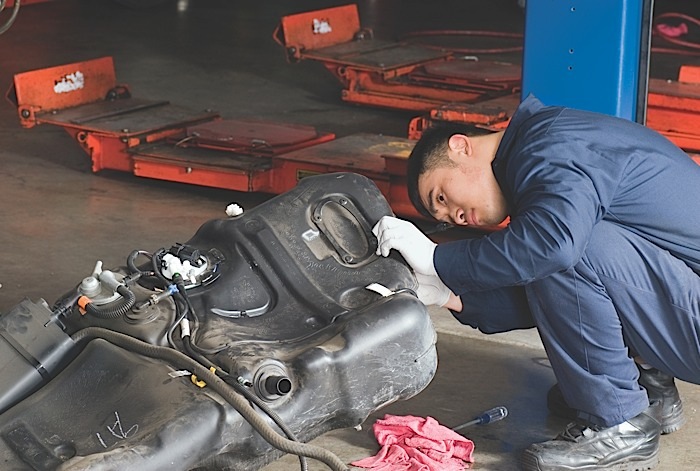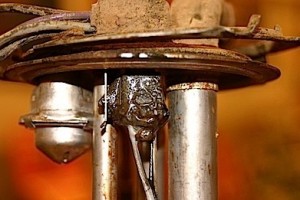Lock Rings and Tabs: The plastics used to make fuel pump lock rings and assemblies can become brittle over time. Any pounding or application of force can cause the assembly to leak. Also, if a metal lock ring has been removed multiple times, the metal can fatigue and distort. In some cases this type of damage can cause an EVAP leak if not addressed during installation and removal. Some fuel tanks, pumps and lock rings require special tools for removal and installation. These tools can prevent damage that can be caused using a screwdriver and hammer.
Baffled: Modern fuel tanks are difficult to clean because of their internal baffling. The fuel tank should be thoroughly dried by circulating air through the tank. In many cases, a fuel tank replacement is the most cost-effective and safe alternative. But, sending the fuel tank out to a specialist may be an easy way to ensure the life of the new pump.
Caddy the Gas: Once the fuel tank has been removed, drain all fuel from the tank. Use only an approved container or a fuel caddy to filter and store the fuel. Use of an old oil drum can cause a fire hazard and re-contamination of a newly installed tank. Specialized fuel caddies typically have filters and pump mechanisms that can pump the fuel back into the vehicle. This can be a real timesaver if you have a car with a full fuel tank.
Missing the Second Fuel Pump: Many rear-wheel-drive vehicles have saddle-style fuel tanks. These typically have two pumps. One in-tank pump supplies fuel to the engine, while the other transfers fuel to the tank with the fuel pump. If the transfer pump is malfunctioning, it can result in stalling and surging after hard braking, cornering or acceleration. On some vehicles, it can cause an inaccurate fuel level signal.
Check the Connections at the Flange: On many GM applications, the wiring harness that connects the assembly flange electrical connector to the fuel pump electrical connector is not properly inspected as a part of fuel system repair. This harness is prone to failure, leading to misdiagnosis and vehicle comebacks. Connector housing cracks, pin and contact looseness, and wire crimp issues can cause symptoms that simulate an issue with the fuel pump. Replacement harnesses are available to make sure the system is operating properly.
Replace ALL the Filters: When a tank is lowered and the fuel tank is replaced, all of the filters, from the sock on the end of the pump to the last filter, should be replaced. Not doing this could cause the early demise of the new fuel pump. Some vehicles may have two filters running in series to catch all the particles without restricting the flow. Also, some fuel injectors will have a small screen on the inlet that can become blocked.
Check The VIN: I have been guilty of not checking the VIN when it comes to ordering the correct fuel pump for a vehicle, but you don’t often find this out until everything is buttoned up and the car is on the test drive. Fuel pumps are engine-specific parts that can vary due to physical and performance requirements.















